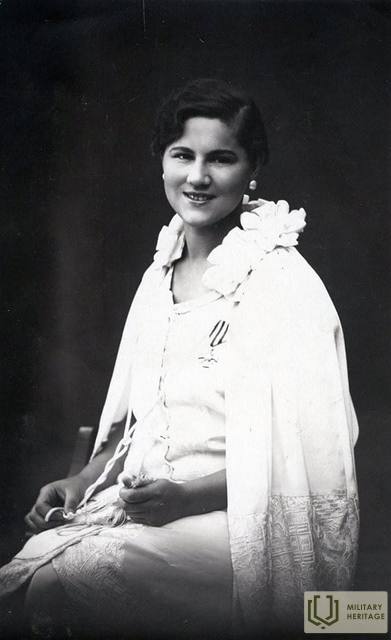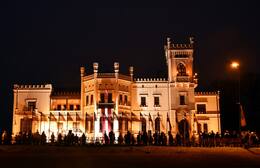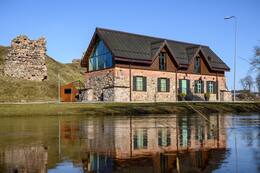7th Sigulda Infantry Regiment's Bermontiad Battle, awarding of Grand Duchess Valija Veščūna with the Lāčplēsis War Order in Alūksne

After the Latvian War of Independence, Grand Sergeant Valija Veščunas was awarded the Lāčplēsis War Order for the battles with the Bermontites near the Plāņi houses on November 19, 1919. Valija Veščunas was one of the first to cross the Lielupe River under enemy fire.
“I already knew how to shoot, and that was in 1919 in the Spilve meadows. By this time our regiments had multiplied. We hid behind haystacks from enemy bullets. I don’t know if anyone was hit or not, but that’s not the main thing. Even the thought that a Latvian soldier might be wounded was too much for my heart. I had already seen the wounded, and this also aroused my hatred for Bermont and his gang of scoundrels. An unconscious dissatisfaction with the precarious existence, of course, existed before, but now it was realized in a concrete form. I also became aware of the necessity and importance of establishing a permanent Latvian state. Bermont went ahead of us, plundered everything, but every soldier had a wife, children or parents, relatives at home, who were thus deprived of a bite to eat. The Bermontites, having come to a foreign land, felt responsible only for their own existence. and belly in front. We were responsible for the further existence of our homeland and people, for the future of this small piece of land. Yes, we chased them all the way to Akmene. We simply did not allow the thought that we could lose, and that is why we won.(..)
Our 7th Sigulda Infantry Regiment was stationed near Alūksne. The ceremony itself (presentation of the Lāčplēsis War Order) went something like this. The troops were lined up in the square, the order was awarded by the President of Latvia, Čakste. I was invited to Alūksne Castle, where a festive lunch was held. After that, we watched the parade of troops through the windows of Alūksne Castle. I only remember a few who were with me - Colonel Frickaus, his wife.”
LNVM virtual exhibition "Cavalier of the Order of the Lāčplēsis War - Valerija Valija Veščuna-Jansone" https://www.youtube.com/watch?v=ZtOtskNlhZQ
Memories of Valija Valerija Veščunas-Jansones. // Ralfs Vilands. She was sixteen. Jurmala, March 30, 1989, No. 13.
Alūksne Museum
LNVM virtual exhibition "Cavalier of the Lāčplēsis War Order - Valerija Valija Veščuna-Jansone" http://lnvm.lv/?p=12079
https://www.la.lv/skukis-kas-nebijas-naves
Related objects
Sudrabkalniņš hill - memorial for fight against Bermondt army
Located in Riga, Pārdaugava, at the intersection of Slokas and Kurzemes avenues.
In early November 1919, during the Latvian War of Independence, street battles between the Latvian Army and Bermont's troops took place in Pārdaugava. The decisive attack on Bermont's army took place in this area. In 1937, a monument was unveiled in Sudrabkalniņš, according to the project of Kārlis Zāle, honoring the fallen soldiers of the 6th Riga Infantry Regiment and highlighting their military qualities.
Designed as a memorial wall – a symbolic fortification, the gate of which depicts a lion blocking the way to the enemy’s attack. Built from stone blocks of the Daugavgrīva Fortress defensive rampart and hewn from the granite left over from the Freedom Monument. The cost of the memorial site amounted to almost 35,000 lats. For comparison, 4 “Ford - Shield V8 De Luxe” cars made in Latvia could be purchased for this amount.
Today, you can visit one of the most impressive memorials of the War of Independence.
Alūksne Museum
The Alūksne Museum is located in an architectural monument of national significance: the neo-Gothic Alūksne New Castle built in the late 19th century. The museum features an exhibition named ‘Memorial Room for Victims of the Totalitarian Regime’, which tells about the fate of the inhabitants of Alūksne municipality in Siberia and the Far East, while the time periods from prehistory to the present meet in the Alūksne history exhibit ‘Feast of the Ages’. It features a separate section devoted to the contribution of the 7th Sigulda Infantry Regiment to the military, culture and public life. The formation of the 7th Sigulda Infantry Regiment began on 20 June 1919 in the Naukšēni Manor. Initially, a battle group of 22 officers and 1,580 soldiers was formed from the reserve battalion of the Northern Latvian Brigade, and was named the Dankers Division. It was included in the 2nd Battalion of the 3rd Jelgava Regiment. On 23 August, following an increase in the number of companies, it became part of the 7th Sigulda Infantry Regiment. Having taken part in the battles against Bermondt, on 5 January 1920, the regiment was transferred to the Latgale front to fight the Bolsheviks. After the signing of the Peace Treaty with Soviet Russia, the regiment guarded Latvia’s eastern border. The Latvian War of Independence saw the deaths of more than 200 soldiers of the regiment, while 85 were awarded the Lāčplēsis War Order. In 1921, the 7th Sigulda Infantry Regiment was stationed in Alūksne. The regiment’s headquarters were set up in the Alūksne New Castle. After World War II, the castle was taken over by Soviet security institutions. As of the late 1950s, the castle housed various cultural institutions: the Culture and Cinematography Department of the Executive Committee, a pioneer house, a library, a cinema and a museum.
Free State Treasure House
The Treasure House of the Free State is located next to the Rēzekne Castle ruins.
The unique exhibition includes hundreds of different historical testimonies from Latvian and foreign private collections, covering the period from 1918 to 1940, revealing the events in the history of Latgale and Rēzekne. It presents the history of military and civilian awards of the First Free State of Latvia, as well as various organisations related to the activities of state and civic organisations in the period from the Latvian War of Independence to World War II.
The collection of military and civilian awards and insignia of the Latvian Free State on display here is the largest one in Latvia.
The Changing Exhibition Hall is situated on the second floor, where a new exhibition is held at least once per year. To date, visitors have had the opportunity to see a unique collection of porcelain objects, luxury clocks from France and paintings depicting various landscapes of Latgale.








